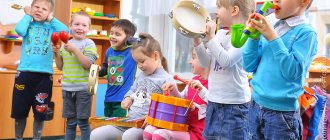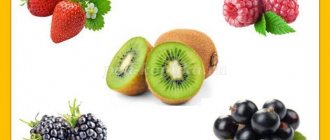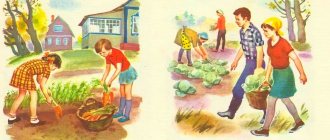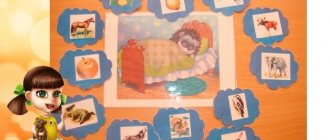Didactic games for preschoolers 4-6 years old on the topic: Fruits, vegetables, berries
Didactic games for preschoolers on the topic: “Fruits, vegetables, berries”
Author: Knis Anna Nikolaevna, senior teacher. Place of work: MBDOU “Kindergarten No. 3 “Smile”, Kalach - on - Don. Description of work: I bring to your attention didactic games for preschoolers on the topic: “Fruits, vegetables, berries.” This material will help educators, children and their parents consolidate children's knowledge about fruits, vegetables and berries in a playful way. Didactic game “The fifth odd one” Goal: Development of skills to classify objects according to essential characteristics, consolidation of generalization words. Didactic material: Cards depicting five objects, four of them belong to one thematic group, and the fifth to some other group. Progress of the game: Children are given the task: “Look at the pictures, name what is depicted on them and determine which object is superfluous. Name the remaining items in one word.” Each participant eliminates the extra item in turn. If he makes a mistake or does not complete the task, his version is offered to the next player to complete. For each correctly completed task they give a chip. The one who collects the most chips wins. Cards for the game: 1. Strawberry, raspberry, kiwi, blackberry, currant. The extra kiwi is because it is a fruit and the rest are berries.
2. Tomato, eggplant, pepper, potato, banana. The extra banana is because it is a fruit and the rest are vegetables.
3. Gooseberries, peach, cranberries, currants, blueberries. The extra peach is because it is a fruit and the rest are berries.
4. Kiwi, apple, pear, peach, tomato. The extra tomato is because it is a vegetable and the rest are fruits.
5. Oranges, apples, radishes, lemon, banana. The extra radishes are because they are vegetables and the rest are fruits.
6. Pear, radish, garlic, cucumber, cabbage. The extra pear is because it is a fruit and the rest are vegetables.
Didactic game “Shop “Fruits, Vegetables, Berries” Goal: Developing children’s skills to accurately describe the appearance (color, shape), taste, and place of growth of fruits, vegetables and berries. Didactic material: Models of fruits, vegetables and berries. Progress of the game: Children choose a seller. The buyer approaches the table on which the models are laid out. Without naming, he describes the fruit, vegetable or berry he wants to buy. For example: “I want to buy berries. They grow in the forest on small bushes. The berries are small, dark blue, round, like peas, slightly flattened on top, juicy and sweet. Jam and compote are prepared from these berries” (blueberries). The child must describe the selected item in such a way that the seller understands what he wants to buy. The seller sells fruits, vegetables and berries (gives the dummy) only to those who have completed the task correctly. Didactic game “Whether in the garden or in the vegetable garden” Purpose: To develop children’s skills to accurately determine the place where fruits and vegetables grow. Didactic material: Pictures of fruits and vegetables, a picture of a vegetable garden and a picture of a garden. How to play: 2 children or 2 groups of children play. The teacher gives one child (group) a picture of a vegetable garden, and another child (group) a picture of a garden. Pictures of fruits and vegetables are laid out in front of the children. A child (group) who has a picture of a garden is collecting vegetables, and a child (group) who has a picture of a garden is collecting fruits. At the end of the game, children check with each other whether they completed the task correctly. Task options: - one group comes up with a riddle about vegetables or fruits, and the other group must find and show the answer in the picture; - tell what can be prepared from vegetables (fruits).
We recommend watching:
Didactic games (verbal) for children 5-6 years old Didactic game for children 5-6 years old Didactic game for teaching literacy to older preschoolers Didactic game for teaching literacy to older preschoolers
Similar articles:
Games to develop motor coordination for children 5-7 years old
Didactic games with natural materials for older children in kindergarten
Educational games for children 5-6 years old in kindergarten
Didactic games to familiarize yourself with flora and fauna for children of the senior preparatory group
Didactic games to familiarize yourself with the outside world in the preparatory group
Didactic games for children 5-7 years old in kindergarten on a lexical topic: Vegetables, fruits
Didactic games for children of senior preschool age on the lexical topic “Vegetables, fruits.”
Author : Tushmakova Natalya Nikolaevna, kindergarten No. 203 “Alice” ANO DO “Childhood Planet “Lada” Description : This material can be used by teachers of senior and preparatory groups to reinforce material on the topic “Vegetables, fruits”.
Working in a kindergarten, whose priority area is speech development, in a group of children with special needs development, I create didactic games on lexical topics myself, based on my own experience and the experience of my colleagues. I would like to present to your attention my new products, which help me a lot when conducting educational activities and joint activities with children in my free time. D/i "Gather the Harvest"
— Guys, autumn has come, vegetables and fruits have ripened at the dacha, it’s time to harvest.
- There are 3 baskets in front of you: in the first basket we will collect fruits whose name has 1 syllable; in the second - in the name of which there are 2 syllables; in the third - 3 syllables.
— How can you check how many syllables are in a word? (slap the word; tap the pencil on the table; put your hand under your chin - the number of times your chin touches your hand, the number of syllables).
— Guys, which basket has more fruits? How many more vegetables and fruits are in the second basket than in the first? Etc.
D/i “Choose names for vegetables”
Children are asked to choose a name for the vegetables. A leader is selected using a counting table, who rotates the arrow in the center of the circle and selects a vegetable.
Children look at clothespins with the names of vegetables.
Reading children read the written names, non-reading children highlight the first sound in the word and look for a clothespin with the desired sound, which is highlighted in red.
D/i "Vegetables and fruits - healthy products"
The game has 2 options.
In the first version,
children are asked to divide the harvest into vegetables and fruits.
We put vegetables in a basket, put fruits under a tree.
In the second option,
children are asked to make a salad from vegetables, and juice from fruits.
Children name the resulting salad (cucumber salad - cucumber) and juice (pineapple juice - pineapple).
Further the task becomes more complicated. Juice from apple and pear - apple-pear, cabbage and carrot salad - cabbage-carrot.
Game "Come up with a riddle"
To reinforce the distinctive features of vegetables and fruits, children are asked to come up with riddles using algorithm class=”aligncenter” width=”629″ height=”472″[/img] For example: - This vegetable grows in a garden bed, it is triangular in shape, orange in color, sweet what does it taste like?
(carrot). — This fruit grows on a tree, it is oval-shaped, yellow, very sour, what is it? (lemon). Dear colleagues, thank you for your attention! I hope this material will help novice teachers in their work.
We recommend watching:
Didactic games for children 5-7 years old: Winter sports Educational game for children 4-7 years old: “Magic bag of cards” Didactic game for social and communicative development for children of the senior group Games for speech development in the senior group of kindergarten
Similar articles:
Assignments on the topic “Forest” for children 6-8 years old
Methods of using didactic games in kindergarten in the senior preparatory group
Fun physical education minutes:
Harvest.
Show actions: carry a ladder, set up a ladder, pick pears, put them in boxes, load them into the car.
2. How a gardener grew an apple tree.
Show actions: the gardener digs a hole, plants an apple tree, whitewashes the trunk of the apple tree, waters, fertilizes, prunes, and collects fruits.
3. Apple.
That's an apple! It's full of sweet juice! (stand up, arms to the sides, stretch) Stretch your hands, pick an apple! (hands up, stretch up) The wind began to shake the twig, it’s hard to pick an apple! (arms up, bend to the sides) I’ll jump up, stretch out my hand and quickly pick an apple! (jumping up, clapping overhead)
Didactic games “Vegetables” for children of senior preschool age
Elena Chuvilina
Didactic games “Vegetables” for children of senior preschool age
Didactic games on the topic “Vegetables” for children 5-7 years old.
1. Didactic game “Whose shadow?”
Target:
develop the ability to find silhouettes of vegetables; learn to name vegetables correctly; learn to distinguish between the concepts of “vegetables”.
Equipment: cards with images of vegetables and their silhouettes.
Option 1. The teacher gives the children color pictures of vegetables. We invite the children to look at them and name them correctly. Next, the teacher shows cards with the shadow of a vegetable. Children must find the right vegetable from the available ones.
Option 2. On one side of the magnetic board we lay out silhouettes of vegetables, on the other - pictures of the vegetables themselves. The teacher suggests attaching pictures of vegetables and their shadows next to each other.
2. Didactic game “What is planted in the garden”
Target:
teach children to classify objects according to certain characteristics (by the place of their growth, by the method of their use, to develop speed of thinking, auditory attention, speech skills.
Game rule. You only need to answer the driver’s questions with “yes” or “no.”
Game action. Whoever makes a mistake gives a forfeit, which he then wins back.
Progress of the game. The teacher asks: “Children, do you know what they plant in the garden? Let's play this game: I will name different objects, and you listen carefully.
If I name something that is planted in the garden, you will answer “yes,” but if something that does not grow in the garden, you will say “no.” Whoever makes a mistake loses.” Educator. Carrot. Children. Yes!
Educator. Cucumbers. Children. Yes!
Educator. Beet. Children. Yes!
Educator. Plums. Children. No!
If someone is in a hurry and answers incorrectly, the teacher can say:
“If you hurry, you will make people laugh. Be careful.
3. Didactic game “Wonderful bag”
Target:
improve the ability to identify a vegetable by touch by its shape, correctly name its color, develop attention, memory, oral speech
Attributes: bag, dummies of vegetables.
Progress of the game: the teacher shows the bag and says:
I am a wonderful bag
I am a friend to all the guys.
I really want to know
How do you like to play?
Children put fake vegetables into a bag. Then, one by one, they take an object from the bag, determine by touch what it is, name it, and then take it out.
4. Didactic game “Tops and Roots”
Target:
Develop the ability to independently recognize vegetables, name them correctly and assemble a whole from parts.
Equipment: Cards with images of vegetables cut into pieces.
Game option: The teacher invites the children to collect pictures of vegetables from two parts “tops and roots.” You must first familiarize the children with the collected pictures so that the children have an idea of what vegetables look like underground and on the surface of the earth.
5. Didactic game “Name as many signs as possible”
(agreement of nouns with adjectives).
Carrots (what kind) - orange, long, sweet, healthy, hard
tomato (what kind) - red, juicy, appetizing, round
Cucumber (what kind) - oval, crispy, green, long, fragrant
6. Didactic game “Potato”
Target:
learn to compose sentences with a specific verb. To consolidate children's knowledge about the work of adults in gardens and fields.
Children are invited to remember the work of vegetable growers. Then come up with a sentence with the given word - action.
Digging In the spring, they dig up the ground to plant potatoes.
Care In order for a good harvest to grow, the plantings must be looked after.
Water In summer the sun is very hot, so you need to water the plants.
Pull out Weeds must be pulled out so that they do not interfere with the growth of potatoes.
Loosen
Dig
Prepare
7. Didactic game “Big - small”
Word formation using diminutive suffixes:
cucumber - cucumber, tomato - tomato, etc.
Logical chains.
Logical chains is a game for older children. But with a child from 2 to 3 years old, you can try to arrange consecutive pictures together and talk about “what comes after what.” On the topic of fruits, I found the following logical chains:
You can download them by clicking on the picture.
Orange.
We bend our fingers one by one.
We shared an orange. There are many of us, but he is alone! This slice is for hedgehogs, This slice is for urchins, This slice is for ducklings, This slice is for kittens. This slice is for the beaver, And for the wolf it is the peel!
Compote.
We depict actions in accordance with the text:
We will cook compote, We need a lot of fruits: We will chop apples, We will chop pears. Squeeze out the lemon juice, drain, and add sand. We cook, we cook compote. Let's treat honest people.
Fruits.
We bend our fingers one by one.
This finger is an orange, He is, of course, not alone. This finger is a plum, delicious, beautiful. This finger is an apricot, growing high on a branch. This finger is a pear, Asks: “Come on, eat it!” This finger is a pineapple, a fruit for you and for us.
A selection of didactic games on the linguistic topic “Fruits”, senior group
DIDACTIC GAMES
ON THE LEXICAL TOPIC “FRUITS”
(senior group)
Teacher – speech therapist Pilipenko I.S.
Game "What's added?"
Goal: to develop visual memory and attention, to activate the vocabulary of nouns on the topic.
Look at the pictures and remember them, I’ll add new ones, and you name them.
(Subject pictures depicting fruits.)
Game "Red, Yellow, Green"
Goal: to clarify children’s understanding of primary colors, to teach them to form adjectives that denote the attribute of an object by color.
Look at the pictures, what color is the fruit, tell me.
(Subject pictures depicting fruits.) Red apple, green pear, etc.
Game "Round, Oval"
Goal: to clarify children’s understanding of basic geometric shapes and to activate their vocabulary of nouns.
Look at the pictures, what shape is the fruit, tell me.
(Round apple, oval banana, etc.)
Game "Fourth wheel"
Goal: to teach children to identify their essential features in objects and make the necessary generalizations on this basis, to activate their subject vocabulary.
Look at the picture, name the extra item and explain your choice.
Apple, pear, tomato, banana.
Apple, orange, peach, banana.
Game “Say Kindly”
Goal: to teach children to form nouns using diminutive suffixes.
Don't yawn, my friend, but say a word. (Apple - apple; lemon - lemon, etc.)
Game "One - Many"
Goal: to teach children to form plural nouns in the nominative and genitive cases. We are little wizards, There was one, but there will be many. (Apple - apples - a lot of apples; pear - pears - a lot of pears, etc.)
Game "Fun Counting"
Goal: to teach children to coordinate nouns with the numerals “one”, “two”, “five”. We always know how many there are, We count everything well. (One apple – two apples – five apples, etc.)
Game “Which from what?”
Goal: to consolidate the use of relative adjectives and methods of their formation in children’s speech. Here is an object, and what did people make it from? (Apple juice – apple juice, etc.) Apple jam – apple jam, etc.)
Game "Choose the word"
Goal: learn to select adjectives for nouns. Children know everything in the world, what happens with us. What apple? – red, round, large, juicy, sweet. Etc.
Game "Fruit Story"
Goal: to teach children to compose a descriptive story using a reference diagram. Look at the fruit, tell me according to the diagram. Speak in order, don’t miss anything.
Game "Borscht or compote"
Goal: to teach how to classify vegetables and fruits, to introduce the specifics of preparing borscht and compote. Develop speech and memory.
A game of attention.
Show your child the picture (when you click on the picture, it will appear in higher resolution. If you decide to print the picture, feel free to save it and send it for printing - it is designed for A4 format):
Ask to find all the same apples.
If you are lucky and have several varieties of different apples at home, then you can play this game with real apples.
Coloring stencils.
You can start painting apples. And so that at the end of the work we get a real masterpiece with neat, even edges, a stencil will help us:
Since kids will be coloring the apple, the stencil will need to be firmly attached to a sheet of paper with a stapler or tape.
Before you start coloring, you can put a real apple in front of your baby and learn to color “from life.” (But not all children under 3 or even 4 years old are able to grasp the meaning of coloring “from nature” - for this you need to “mature”).
Conversation about fruits L.K. Schleger. 1913
Preparing for the conversation.
There are different fruits in front of the children. They name them, determine their shape, colors. Determined by touch and taste with eyes closed.
Catalogs of fruits should be at hand; drawings in paints (that is, color pictures); artificial fruit
Conversation.
What do fruits grow on? What is the name of the tree on which apples grow? Can plums grow on an apple tree? What does a ripe apple look like? What does it taste like? (Sweet, juicy). Who colored the apple so much? What protects the apple pulp? (Skin). When is the apple ripe? The beauty of an apple tree hung with ruddy apples. Has anyone ever seen an apple tree with apples? What are the apples sitting on?
Who can tell me how an apple grows? Is it always so big and ruddy? What color is an unripe apple? What does it taste like? Before the apple appears, the apple tree blooms. When does it bloom? In the spring. Has anyone seen an apple tree in bloom? We'll look at it in the spring, but for now let's look at the picture.
Let's see what's inside the apple , cut it - one lengthwise, the other across. What are the seeds in and how many are there? Why do apple trees need seeds? Why do you need pulp? She guards the seeds. What color are ripe seeds? What about the unripe ones?
What kind of seeds do cherries have? At the plum?
Who eats ripe fruits? Do some people eat and love them? Do people eat seeds? They spit them out. What do birds eat? Seeds fall on the ground, and what grows from them?
What do you sometimes find in apples, pears, plums? Worm. How did the worm get into the apple tree? Does the worm remain in the apple? He gnaws it and comes out (find an apple with a worm in it). A worm is made into a pupa, and a pupa is made into a butterfly.
What do we make from fruits? What do we make jam from? Has anyone ever seen dried fruit? Show and try. What else is made from fruits? Kvass, liqueur.
Do we grow grapes? What do they make from it? What other fruits do you know that grow in warm countries? Oranges, tangerines, lemons. Are the skins of oranges and lemons as thin as those of an apple?
What fruits does an oak tree or a Christmas tree have? Who collects and eats them? Is this fruit?
Children's work on the topic "Fruits".
- Modeling fruits, drawing them.
- Cutting and pasting (applique).
- Cutting out pictures of fruits from catalogs and magazines.
- Illustration “Apple picking”.
- Fruit stand (making a model for children's games together with the children)
Question for educators to consider:
Exactly 100 years have passed since the publication of this conversation for young children by the talented teacher Louise Karlovna Schleger! Have we and our children changed? What is different about the conversation about fruits by L.K. Schleger from modern conversations about fruits in kindergarten? What requirements for a conversation with children were taken into account when compiling this conversation? What would you change about it?
You will learn more about conversations with children and about our history of methods for developing children’s speech from the article “Conversation in kindergarten” based on materials from the book by E.A. Flerina “The Living Word in a Preschool Institution.”





